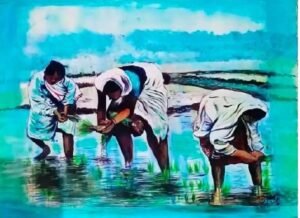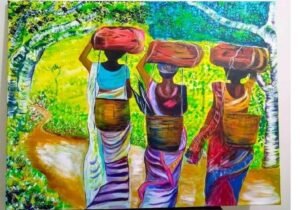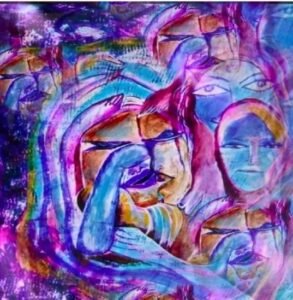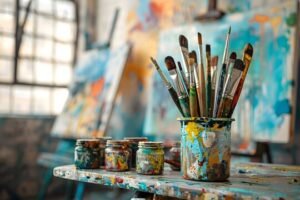Painting: A Multidimensional Exploration of Visual, Cultural, and Liberal Arts
Aditi Deka Pathak
Visual Artist, Art Columnist, Author, Editor & Researcher
Guwahati, Assam, India
1.Introduction:
For ages, painting has been used as an artistic medium to capture the essence of society, culture, emotion, and philosophy, providing a window into the human condition. Painting has changed over time, from the earliest ancient cave paintings to modern digital art, yet its fundamental elements are still entwined with the liberal, cultural, and visual arts. The relevance of painting, its incorporation into other creative forms, and its function as a link between visual aesthetics, cultural expression, and the larger liberal arts heritage are all explored in this article.
2.Painting as Visual Arts:
Painting is a visual art at its most basic level. The observer is immediately affected by the use of colour, composition, texture, and light. Painting’s visual components, such line, form, and perspective, are not just technical aspects; they are also means of communication that let painters convey concepts, feelings, and ideas that are beyond the realm of language.
Painting has consistently challenged the limits of what is aesthetically feasible, from the early frescoes of the Renaissance to the abstract movements of the 20th century. The representation of light and texture was transformed by techniques like chiaroscuro, impasto, and pointillism, which gave us new perspectives on and ways to engage with the world. Whether realistic or abstract, a painting’s visual impact can arouse a variety of feelings and ideas, from calm to reflection or even agitation.

Painting 1: Women at Work in the Paddy Fields, 30 x 36 inch.
Oil on Canvas, 2019
Image Curtsey: Author’s Own Creation
Additionally, painting on canvas enables the manipulation of time and space. What a viewer sees is not just an image; it is a world that the artist has constructed, providing a portal into a deeper, frequently metaphorical understanding of the subject matter as well as a representation of reality.
3.Painting as Cultural Studies:
Painting is a significant cultural artefact that goes beyond its aesthetic value. The ideals, convictions, hardships, and victories of the societies that create art are reflected in it. We may learn about the cultural climate of a given time period through painting. With its emphasis on humanism, the Renaissance, for instance, frequently portrayed religious and mythological themes, exposing the values of the time, which included faith, reason, and the ideal of the “perfect human form.” On the other hand, 20th century painters like Picasso and Frida Kahlo frequently explored gender, identity, and conflict in their works, reflecting the political and social unrest of their era.

Painting 2: The Women of the Village, 30 x 36 inch.
Oil on Canvas, 2019
Image Curtsey: Author’s Own Creation
Every artwork captures a moment in time of its cultural setting, shaped by world events, technological developments, and sociopolitical conditions. For example, artists such as Dorothea Lange depicted the human condition via grim depictions of adversity during the Great Depression. In a similar vein, artists have used paint to represent colonial histories, indigenous struggles, and international wars, giving voice to under-represented groups and challenging dominant narratives.
Additionally, painting is frequently used as a cultural preservation strategy. In addition to narrating historical events, Chinese ink wash paintings, indigenous Australian dot art, and Egyptian tomb paintings all contribute to the establishment and maintenance of cultural identity. Artists continue to experiment with cultural hybridisation in today’s globalised environment, fusing old methods with contemporary concepts to produce fresh manifestations of cultural identity.
4.Painting in the Context of the Liberal Arts:
Additionally, painting holds a special place in the liberal arts tradition, which encompasses a wide range of academic fields such as literature, philosophy, history, and the social sciences. Painting is a liberal art that incorporates interpretation, inquiry, and critical thinking in addition to technique.

Painting 3: Illegitimate Birth, 30 x 36 inch.
Acrylic on Paper, 2019
Image Curtsey: Author’s Own Creation
The foundation of the liberal arts is the belief that a well-rounded education ought to promote a greater comprehension of people and the wider world. As a liberal art form, painting encourages both the artist and the observer to participate in this investigation of the human condition. Paintings raise issues of existence, morality, and identity through the use of metaphor, allegory, and symbolism. Painting is a tool for introspection and discussion, whether it is about the human form or abstract concepts, pushing both the artist and the viewer to consider the world critically.
Furthermore, painting has frequently been incorporated into other liberal arts fields, fostering interdisciplinary discussion. Visual art and other intellectual endeavours can interact enrichingly since artists frequently study philosophy, politics, literature, and history. Works that transcend artistic bounds have been produced as a result of the interaction of literary or philosophical concepts with visual representation.
5.The Evolving Role of Painting in Contemporary Society:
Even though new media and forms of expression have become more popular in the art world, painting still holds a significant place in modern culture. The possibilities of painting have increased with the introduction of digital technology, such as virtual art spaces and digital painting. The classic technique of painting on canvas is still captivating and tactile, providing a special bond between the artist and their material in spite of these technological developments.
Painting is not only a historical practice but also a dynamic and changing art form, as demonstrated by the frequent use of painting by contemporary artists to address societal issues, personal tales, and global concerns. Through their works, artists like Banksy, Kehinde Wiley, and Julie Mehretu examine issues like politics, race, and power, demonstrating that painting still has the capacity to inspire, challenge, and spark conversation.
Additionally, collectors and institutions are embracing both ancient and contemporary works, reflecting the renewed interest in classical painting techniques in the global art market. People from all areas of life are still drawn to painting’s visual language, confirming its importance as a cultural and intellectual force.
6.Conclusion:
Painting is situated at the intersection of the liberal arts, culture, and visual art. It is a vibrant and diverse media that keeps developing while retaining its strong foundation in human expression and history. It enthrals the eye and psyche as a visual form, providing room for individual interpretation and emotional bonding. As a cultural artefact, it preserves and challenges cultural narratives by reflecting and influencing the society in which it is created. It also promotes critical thinking, philosophical contemplation, and intellectual inquiry as a component of the liberal arts.
In this diverse capacity, painting continues to be a potent and timeless influence in the realm of art as well as in the larger cultural context, enabling us to investigate the intricacies of the human condition both visually and conceptually.

